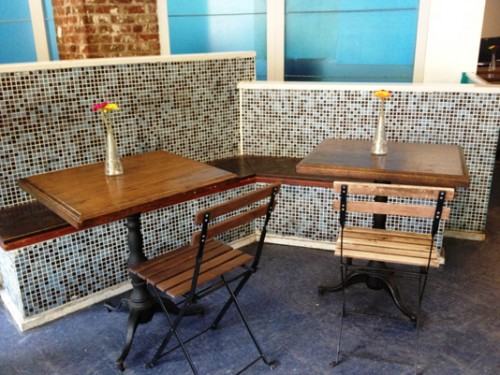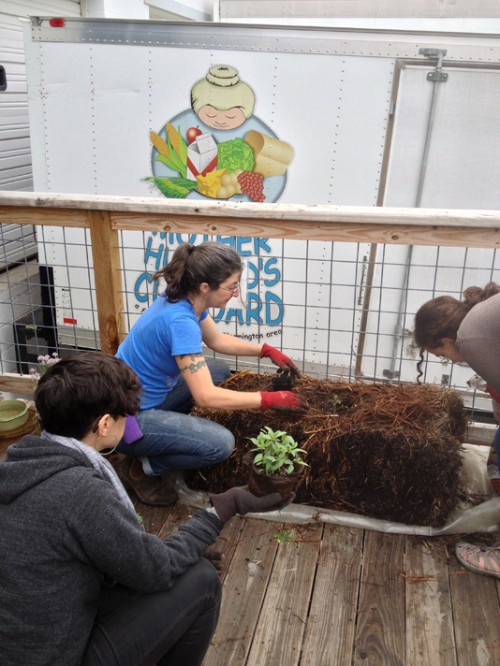Back in March we shared reflections from the team at Mother Hubbard’s Cupboard (Bloomington, Indiana) after a site visit to their Nourishing Connections partners Neighbors Together (New York, NY) in Brooklyn, NY. This month, we are checking in with the community learning pair after Neighbors Together’s site visit to Indiana. Read Neighbors Together’s reflections from Denny Marsh and Amy Blumsack below.
 The cafe at Neighbors Together in New York City.
The cafe at Neighbors Together in New York City.
Neighbors Together is a soup kitchen and community-based organization located in central Brooklyn. Our mission is to end hunger and poverty in Ocean Hill, Brownsville and Bedford-Stuyvesant, three of the lowest-income neighborhoods in New York City. We serve 2,000 nutritious meals per week, connect our members to vital resources such as housing and job training, and address hunger and poverty at their root causes by organizing our members to advocate for better public policies.
In mid-May, Neighbors Together staff members Denny Marsh and Amy Blumsack had the pleasure of visiting Mother Hubbard’s Cupboard (MHC) in Bloomington, IN, as part of WhyHunger’s national peer-to-peer learning program, Nourishing Connections. MHC is a client choice food pantry that also engages its patrons in a wide range of nutrition education, gardening and food justice oriented programming.
We went to MHC to see their programs firsthand and learn more about how they incorporate education on nutrition, growing food and maximizing the value of each dollar into the operations of their pantry. Since Neighbors Together has been thinking about ways we can begin to incorporate growing food into our work in central Brooklyn, it was very exciting to see MHC’s extensive community gardens, whether it was their on-site demonstration garden or any of the community gardens around Bloomington that they help steward.
MHC moved into a new facility in December, and one of the things that struck us the most was the palpable sense of love and care that they have imbued into every aspect of their new facility; the building is surrounded by plants and trees, each carefully labeled. Veggies and herbs abound in planter boxes, hay bales, pots, tires and carefully tended rows in front of their building. Once inside, the whole place is painted in bright, cheerful colors, patron artwork is displayed on their pantry walls and everywhere you look helpful information about cooking, gardening and how to utilize their programs is presented in a way that is visually pleasing and easy to understand.
 Planting at Mother Hubbard’s Cupboard in Bloomington, Indiana.
Planting at Mother Hubbard’s Cupboard in Bloomington, Indiana.
We were thankful for the reminder that our physical surroundings truly affect our frame of mind and either serve to affirm or diminish people’s sense of dignity. Since returning to Neighbors Together, we’ve done an overhaul of our Community Café, replacing our run down tables and chairs with a new restaurant-style set donated to us from an upscale bistro in Manhattan. We’ve taken down the disorganized flyers on our Café walls to reduce visual clutter, and we are in the process of replacing them with clearer information grounded in positive messaging. We’ve even added the touch of flowers in vases to each table in our Community Café. Our members noticed the difference right away — we’ve heard over and over again that our Community Café now looks like an actual restaurant.
Neighbors Together’s staff has been discussing the best ways to grow plants and herbs in our space. We feel strongly that integrating greenery into our Café is not only aesthetically pleasing, but it also offers therapeutic benefits, facilitates conversations about growing food or cooking between members and staff, is a tangible tool for nutrition education and creates more space for conversations about food justice.
During our visit to MHC, we received so much encouragement and opportunity to experience planting and growing hands-on. Getting our hands dirty planting tomatoes and eggplants and exploring the different community gardens around Bloomington was a great lesson in “don’t let ‘perfect’ be the enemy of ‘good,’” meaning that it’s better to dive in, try it out and learn from what happens instead of waiting until we know we can implement something absolutely perfect from the beginning.
With this lesson in mind, we decided starting small was better than not starting at all. Upon returning to Brooklyn, we purchased a variety of herbs and planted them in pots that now sit in the windows of our Community Café. These herbs are one of the first things people see as they approach Neighbors Together, and have become a visible element of our member’s experience when dining in our Café. While these changes may not seem significant in the face of our mission to end hunger, what we were reminded of at MHC is that it’s often the little things that make a big difference in the daily experience of our low-income members.
A project of the National Hunger Clearinghouse, Nourishing Connections connects emergency food providers to resources and helps bring together like-minded organizations to foster shared learning. Mother Hubbard’s Cupboard and Neighbors Together are working together around community organizing, client advocacy, gardening and food justice in the emergency food system through the program’s hallmark Community Learning Project (CLP), a one-year peer-to-peer learning exchange which facilitates knowledge and resource sharing and builds institutional capacity for emergency food providers in the community food security/food justice movement.


